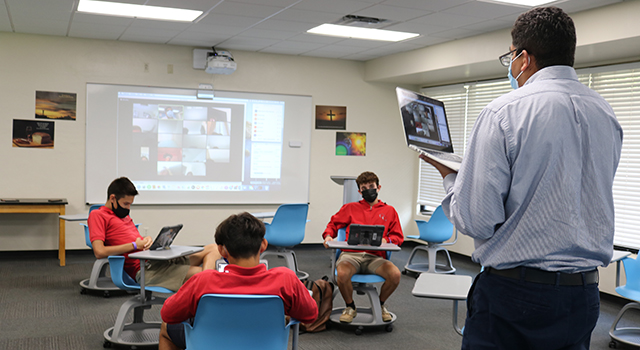By Linda Reeves - The Florida Catholic Palm Beach
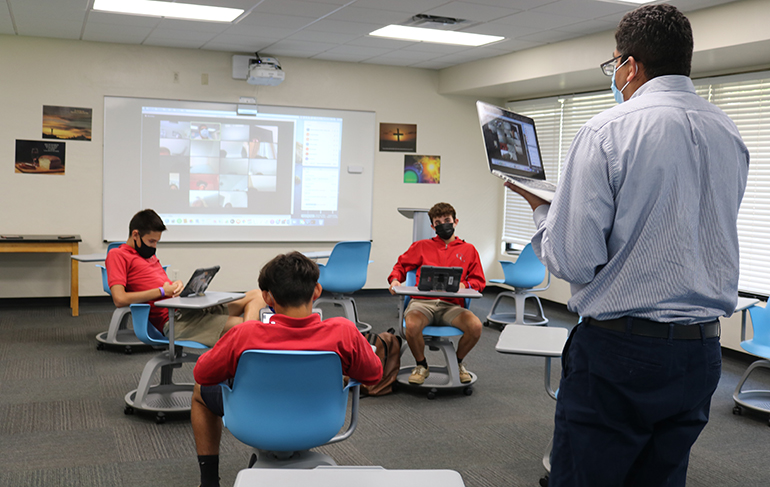
Photographer: LINDA REEVES | FC
Nelson Araque moves about his classroom talking and asking questions to the students sitting in front of him as well as those connected virtually online. He is busy multitasking through the entire session trying to keep the class interesting and his students engaged.
From the editor: In September 2020, schools in the Archdiocese of Miami reopened after closing in mid-March due to COVID-19. The 2020-21 school year began with all students learning online, but in October, archdiocesan schools gave parents the option to send their youngsters back to campus for in-person learning or to keep their kids at home, learning online. For archdiocesan teachers, that meant providing simultaneous instruction to in-person learners while also teaching students who were visible only on computer screens.
Much has been written about the “heroism” this past year of front-line workers in hospitals, grocery stores and other service industries: Those who did not have the luxury of working from home during the pandemic. We think archdiocesan educators also belong in that “heroic” category for the way they accepted the teaching challenges posed by the pandemic and adapted to the “new normal.”
To give our readers a taste of that “new normal,” we sent reporters to a Broward high school and a Miami-Dade elementary school, to spend a day with a teacher in a hybrid classroom. Here’s what that was like.
FORT LAUDERDALE | Nelson Araque spent years in college preparing for the teaching vocation to which he felt called. But his ample schooling and nearly 25 years of teaching experience never prepared him for the challenges he faced this school year.
“We have a teacher’s guide, but in the pandemic, it didn’t work,” said Araque, a teacher at Cardinal Gibbons High School in Fort Lauderdale for the past 15 years.
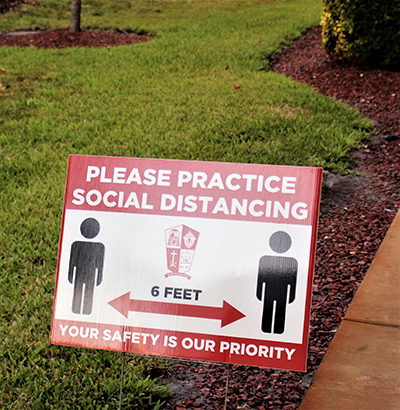
Photographer: LINDA REEVES | FC
Distancing signs are part of Cardinal Gibbons High's campus during the pandemic days.
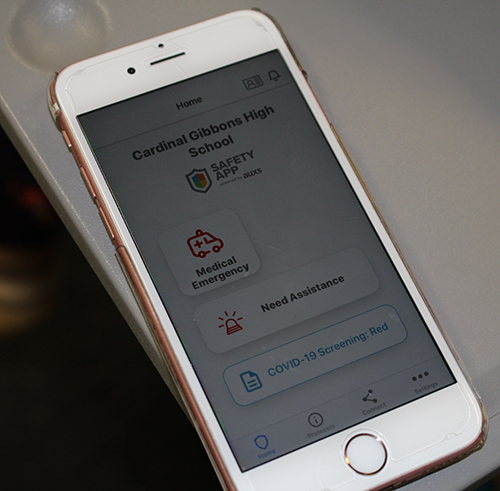
Photographer: LINDA REEVES | FC
A mobile safety application is part of Cardinal Gibbons High School students' school gear these pandemic days. Upon arriving to school, students use the application to check in and get cleared for their school day.
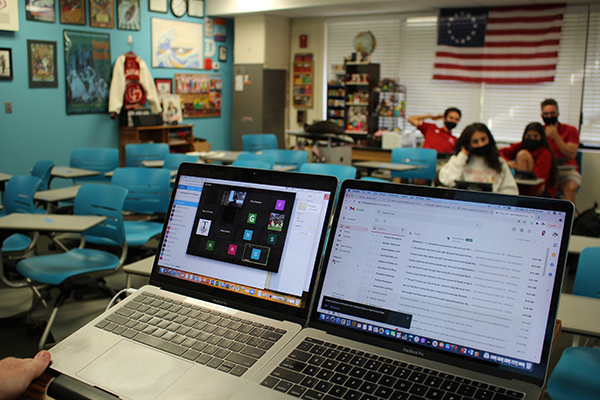
Photographer: LINDA REEVES | FC
A small class at Cardinal Gibbons High is shown preparing for history class to begin May 25, 2021. Online students are shown checking into class on the computer screens, joining the hybrid classroom.
Since COVID-19, Araque’s life as a teacher has changed considerably. Nearly everything, from what he did and when and how he did it, is different than it was pre-pandemic. But he said he still loves his job, and it is never dull.
“I like to be around students and share with them what I know,” said Araque, a 10th and 11th grade theology teacher who is married to another Catholic school teacher. He and his wife have one child. “I like to see the students understanding what I am teaching them, and I like to see them developing,” he said.
The Florida Catholic spent time on the Gibbons campus at the end of May to experience a day in the life of an educator and to observe the “new normal” teaching practices used to educate students during this abnormal time. For now, everything is different.
After stepping onto Cardinal Gibbons’ campus, we noticed an unusual silence. None of the chatter that used to fill the walkways and halls. No students hanging out, fooling around, laughing. Due to the pandemic, youngsters have not been allowed to congregate. Distancing signs are posted here and there. Everyone on campus sported a facemask and colored wristbands, issued after they checked in using a mobile safety app that basically asks them if they are feeling well.
Teachers arrived 30 minutes to an hour early to their hybrid classrooms to prepare for their lessons and get all the electronic devices, gadgets and gizmos fired up. They made any last-minute adjustments to their teaching plans but had no way to prepare for sudden glitches. Most importantly, they slipped on latex gloves and sprayed the desks with disinfectant before students arrived, made sure the desks were spaced apart and secured their own masks.
“Good morning,” said Araque as he greeted his 10th grade students. Wearing masks, they strolled into the classroom with laptops and cellphones in hand. They nodded, placed their cellphones on a table near the door — a classroom procedure — and took a seat at a desk.
Four boys and a girl showed up for in-person sessions during our May visit. Araque clicked on the meeting link for his online class and faces of students learning at home began to pop up on his computer screen. “I just had one student at home say he is out of power,” said Araque, shaking his head and showing his concern. “What do I do with her.”
He began an attendance check. “Please type your name in the box,” he told his 20 online students. “Show me your faces,” he said as he carefully made a head count.
Faces continued to appear. He projected the unmasked students on a big screen erected in front of the classroom. Some of the students waved and smiled. One boy joined yawning and stretching. Another teen was playing with his dog.
WARNING: ‘I CAN SEE YOU’
“Juan, what are you doing? Whatever you are doing, remember I have a camera. I can see you there,” warned Araque.
Once everyone was accounted for, classes began with a prayer and then, lessons. “We are going to study about the nature of the Church,” said Araque. “The Church is apostolic. What does that mean?”
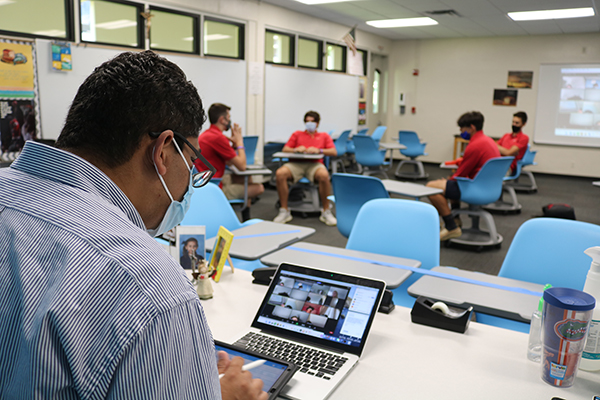
Photographer: LINDA REEVES | FC
Nelson Araque multitasks and stays constantly busy during his theology class at Cardinal Gibbons High School as he teaches his online and in-person students and tries to keep them engaged and interested.
He moved around the room constantly, full of energy, gazing at his students in the classroom and then shifting his focus to his online students on the computer he held in his hand. He stood. He sat at a desk. He lectured. He walked to the front of the room and to the back. He challenged the youngsters with questions and nudged them to explain their answers more fully. He was constantly in a multitasking mode, going at top speed.
“It is all about motivation with hybrid teaching,” said Araque. “It’s two classes. I need to be there, and I need to be here at the same time. You have to constantly think about the people in the screen and also the people sitting in the classroom. You have to motivate your students. You have to be creative. It is a lot of work.”
Hybrid classes are tough from what we observed. Both teachers and students had to adjust. No one knows what a day will bring. It is not unusual for a student to have problems getting online or experience some type of computer glitches. They hesitate to answer questions. They don’t fully participate. Then, there is Zoom fatigue, a common term these days referring to the tiredness felt from staring at a computer for long periods of time. Classes these days include short breaks.
‘BETTER TO BE IN CLASS’
“I will be happy when things are back to normal,” said Cortney Reiss, an 11th grader who came back to campus because online classes were not for her. “I miss my classmates who are not coming to school. It is more fun when everyone is in the classroom. There is more participation and more conversation.”
“I came back in October,” said Noalani Valle, also in 11th grade. “I didn’t like being at home online because I get distracted easily. For me, it is better to be in class. I like being with friends. I like being with my teachers.”
Cardinal Gibbons’ enrollment was 1,100 this year although the number of students on campus varied from day to day. Students had to isolate after coming in contact with someone with the virus, or of course if they felt sick.
“We have about 600 online,” said Erin Herbert, Gibbons’ marketing and communications specialist. “The number of students on campus varies day to day. We have 400 to 500 coming to the campus.”
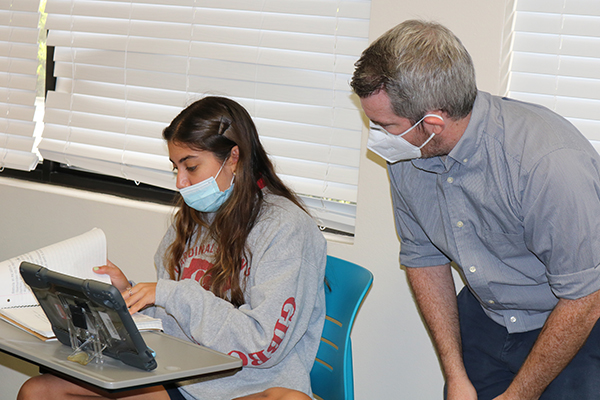
Photographer: LINDA REEVES | FC
Jena Masri, an eleventh grader, gets some help from her teacher, Brian Dunne, during history lessons. She is back on campus and participating in classes with other students while others stay at home and join the sessions online.
Brian Dunne, a history and government teacher at Gibbons, has been an educator for 10 years, teaching at all levels. He also coaches soccer and teaches evening classes at Florida Atlantic University in Boca Raton. “You have to love kids,” he said when asked about being a teacher.
He and his brother, Father Martin Dunne, parochial vicar at St. Joan of Arc Parish in Boca Raton, both graduated from Cardinal Gibbons. Brian married his high school sweetheart. They have child number two on the way.
Dunn was in his classroom preparing for the day when we arrived on campus a little after 7 a.m. He said he will never forget this school year. “I have tried to establish a sense of normalcy in my classes.”
He had up to 10 students on campus for classes, while 15, most of the time, participated online. He had to reinvent his teaching plan for his hybrid classroom. “Hybrid teaching is a different animal,” he explained. “I give quick lectures. Then I allow them to work on an assignment.”
Dunne used all sorts of new educational technology including Blooket, Zoom and Kahoot to keep students interested and engaged. “I had to learn all of the applications to be able to teach during COVID,” he said.
TEACHER, MENTOR, ROLE MODEL
He confessed that teaching in the hybrid classroom requires a great deal of time, and the instructional pace tends to be slower. But he added that students still got the best in Catholic education. “It is about quality of education over quantity.”
Teaching methods may have changed and books, pencils and paper have been replaced by iPads and laptops, but as we saw at Gibbons, major aspects of Catholic teaching remain constant: dedication, compassion, caring and excellence.
“You have to be a teacher, a mentor and a role model,” said Dunne. “The kids have to know that you are there for them. They have to know you are on their side. We are there to help them on their path of life.”
With the pandemic apparently winding down, hybrid education won’t take place next year in archdiocesan schools. Parents who want their children to continue learning from home will have to enroll them in the ADOM Virtual School.
“Next year, we hope that our classes will be full,” said Araque, who is praying for the day he will truly be with all his students again. For now, he remained in touch at a distance. In a special corner in his classroom, he displayed the notes and thank you cards his students sent him, showing their appreciation for being there to help them get through these tough times.
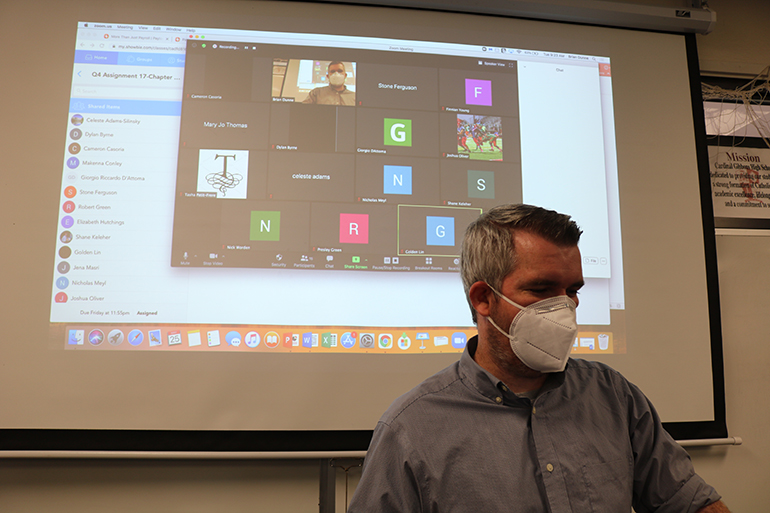
Photographer: LINDA REEVES | FC
Brian Dunne teaches history to a class of juniors during sessions at Cardinal Gibbons High School May 25, 2021. The screen behind him reveals online students participating in class alongside the students sitting in the classroom.
